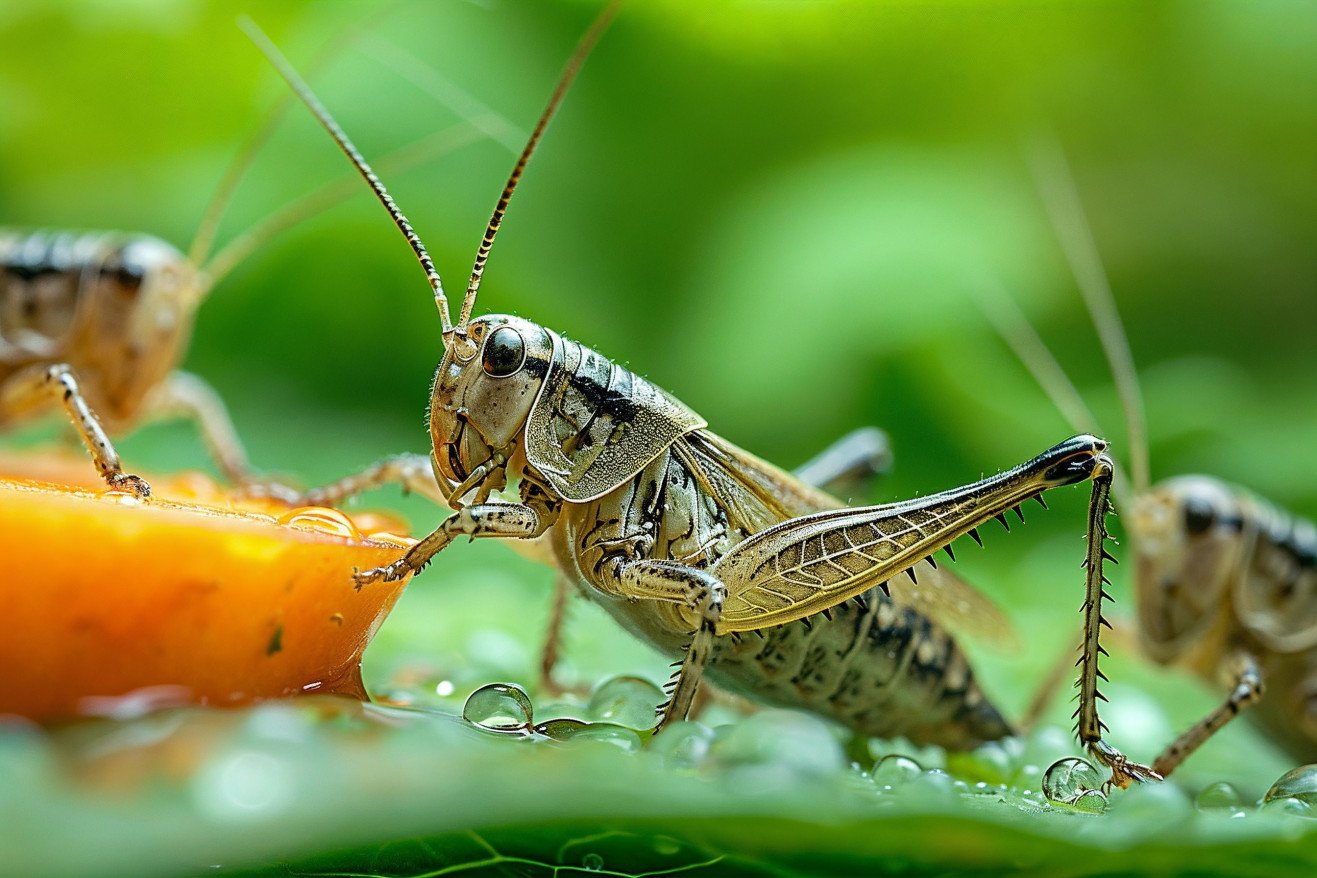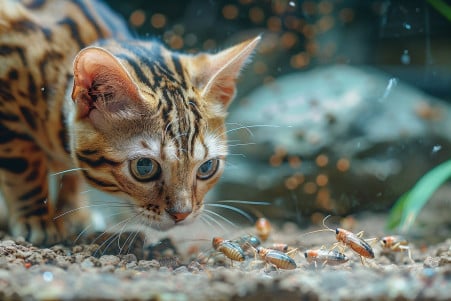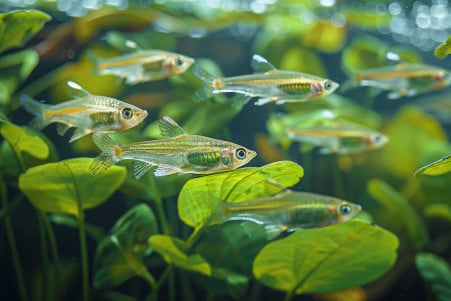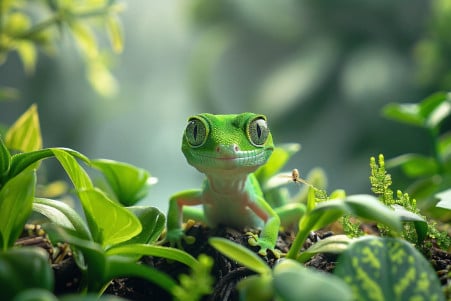Optimal Cricket Nutrition: What to Feed Your Crickets for Peak Health
6 February 2024 • Updated 6 February 2024

While crickets are best known for their chirping, their diet is just as important and requires a lot more thought and variety. Crickets need a well-rounded diet that includes high-protein foods, as well as fresh fruits and vegetables. This can be achieved through commercial cricket food, grains, tropical fish flakes, and gut-loading formulas. Make sure to always have clean water available and avoid foods that are too wet, as they can lead to mold.
The sections below will cover a wide range of entomology, animal nutrition, and sustainable farming studies to help you understand what crickets need in their diet. These studies will help you understand how to best feed crickets so that they grow and stay healthy, and so that they can be used as a source of nutrients for other animals. You’ll also learn about cricket gut loading, hydration, and how different diets impact crickets.
What are the most important components of a cricket's diet for optimal health?
Meeting the Varied Nutritional Needs of Crickets
Understanding the different nutritional needs of crickets is important because there is no one-size-fits-all answer. The nutritional needs of crickets change drastically throughout their life stages and depending on their purpose in the ecosystem.
For example, baby crickets and female breeders need a high-protein diet to support their growth and egg production, respectively, as noted by Critter Depot. This can be met with high-quality cricket chow or other options like dog kibble or chicken feed.
Not only is a varied diet a luxury, but it is also a necessity for a healthy cricket colony. Critter Depot suggests adding leafy greens, beta-carotene-rich vegetables, and grains to make sure that crickets are getting all of the nutrients that they need. However, it is important to balance gut-loading—feeding crickets nutrient-rich foods before they are fed to other animals—and the day-to-day care of the colony.
Common mistakes in feeding include imbalanced diets, overfeeding, and not keeping the enclosure clean, which can lead to the spread of disease. Bantam Earth suggests removing uneaten food and dead crickets as soon as possible to keep the enclosure clean.
Looking into the details of cricket nutrition shows that they are omnivores and need variety, just like in the wild. This knowledge sets the stage for the next topic in cricket care: the art of gut loading.
The Gut Loading Process
Gut loading is a method of increasing the nutritional value of crickets that will be used to feed insect-eating pets. During gut loading, crickets are fed a diet that is high in nutrients for a short period of time before they are offered as food, thereby increasing the nutritional value that will be passed on to the predator.
The Critter Depot explains that a gut-load mix often includes dry grains, which are a good source of calcium, protein, and vitamins.
Some of the most common gut-loading foods include fresh vegetables, whole wheat breads, grains, and specially formulated cricket foods.
According to ScienceDirect Topics, gut loading should be done for a period of time between 12 hours and 5 days to ensure that the crickets are fully loaded with nutrients. The length of time that the crickets are gut loaded is one of the most important factors in determining how well the nutrients will be passed from the cricket to the predator.
When reptiles like bearded dragons or chameleons are fed gut-loaded crickets, it helps to ensure that they get the nutrients that they would normally get from a more diverse diet in the wild. ScienceDirect Topics also notes the importance of working with veterinarians to ensure that the gut-loading process is done correctly, including calcium dusting, which is important for reptile nutrition.
In the end, this makes sure that the crickets will provide a well-rounded and nutritious meal that will help the insect-eating animals that eat them grow and thrive.
Exploring the Nutritional Value of Crickets
The common cricket is not only a noisy insect but also a nutritional dynamo that offers a rich source of protein, fat, vitamins, and minerals. According to a study from the National Center for Biotechnology Information cited by Healthline, crickets are a better source of protein than more traditional animal-based sources like beef, chicken, and pork.
In fact, the protein content of crickets can range from 13.2 to 20.3 grams per 100-gram serving, depending on the species. In addition, crickets are full of essential amino acids and contain more iron than beef.
What crickets eat has a big impact on their development, health, and usefulness as a food source for other animals. Research has shown that diets that are high in protein and include a variety of vitamins and minerals can help crickets grow and reproduce more effectively.
This knowledge of cricket nutrition is used to inform their feeding, which is done to ensure their health and to maximize their potential as a nutritious food source for pets and other animals, according to The Critter Depot.
That said, there are also some potential health concerns associated with eating crickets. For example, people who are allergic to shellfish may experience allergic reactions to crickets because they contain chitin, according to Healthline. It’s also important to make sure that crickets are sourced from farms that follow strict safety protocols to reduce the risk of pathogens.
Understanding the nutritional value of crickets and the importance of their diet brings us to another important part of their health: hydration, which we’ll explore in the next section on cricket well-being.
Why Water Is Important for Crickets
Water is an important part of a cricket’s diet and is necessary for their survival and well-being. Like all living things, crickets need water to help with essential bodily functions, such as transporting nutrients and getting rid of waste.
If crickets don’t get enough water, they can become dehydrated, which can lead to a lack of energy, a loss of appetite, and, eventually, death. There are several ways to make sure your crickets don’t become dehydrated.
For example, Cricket King recommends feeding smaller crickets fruits and veggies with high water content to reduce the chances of drowning. Ovipost says that larger crickets can benefit from hydration crystals or wet sponges placed in shallow dishes.
Dehydration can be detected by a lack of movement and a dry exoskeleton. Meadowia recommends misting enclosures or using drip feeders to ensure a constant water source. To keep the right humidity levels in your cricket’s home, it’s important to make sure that their environment is stable and well-ventilated and to check for dryness regularly.
A good way to make sure your crickets are getting enough water is to use shallow trays with pebbles and water, which will allow them to drink without the risk of drowning. Changing the water and keeping it clean will help ensure the health and longevity of your cricket colony, which leads us to the next important part of cricket care: making sure they’re eating the right things to help them grow and thrive.
Customizing Diets for Healthy Cricket Colonies
The focus on customizing cricket diets to optimize growth and health is based on evidence that shows that diet has a significant impact on cricket development. For example, a 2020 study published in PubMed by Bawa found that crickets fed a high-protein diet had higher protein and essential mineral content, including phosphorus, potassium, calcium, and sodium.
This means that crickets fed a diet that contains at least 22% protein will lead to much faster growth and better health.
Another study, published in PMC by Christoph Scherber, that delves into the relationship between diet and fecundity, found that diet and social environment both affected the time it took for crickets to develop, as well as their lifespan and overall fitness. This means that the health and reproductive success of crickets is not just based on what they eat, but also the conditions in which they eat.
Dietary composition also impacts the health and nutritional value of crickets, as shown in a study by Bartosz Łozowski published in Scientific Reports, which found that diets high in monosaccharides had a significant effect on the developmental success and biochemical composition of crickets, showing that a balanced macronutrient diet is important.
Based on these findings, researchers have developed cricket diets that will lead to healthier crickets that are more useful as feeder insects. In addition, the environmental benefits of cricket farming, including less land and water use, mean that diet is key to sustainable cricket farming. A well-balanced cricket diet is important for the crickets themselves and the larger ecosystem that they are a part of.
Commercial Cricket Diets: What’s in Them and Why They’re Used
Commercial cricket diets are designed to provide crickets with a complete and balanced diet that is essential to their nutrition, development, and well-being. These diets are typically made from powdered grain-based formulations that are high in protein, essential vitamins, and minerals.
According to The Critter Depot, common ingredients include high-protein sources like chicken feed, as well as gut-load formulations that are specifically formulated to improve the nutritional content of crickets that are intended to be used as feeder insects.
A study published in PMC demonstrates the nutritional value of these commercial diets, showing that they can lead to greater biomass and faster cricket development than some of the homemade diets. However, self-selection studies like this one are important for creating optimized diets that take into account the natural dietary preferences of crickets and improve their overall well-being.
From a financial standpoint, commercial diets are a bit of a mixed bag. As the PMC study points out, while commercial diets are more costly than homemade diets, they also save time and effort.
As a result, cricket owners who weigh the pros and cons of each option may find that commercial diets are a more convenient, if more expensive, option than making their own cricket diets.
This knowledge of commercial cricket nutrition helps ensure that cricket owners make informed and responsible choices about what to feed their crickets, taking into account both their well-being and the cost of their care.
In Conclusion: What You Need to Know About Cricket Nutrition
When we put all of this information together, it’s easy to see that a well-rounded diet is important for the health and well-being of these adaptable creatures. Everything from protein to fruits and vegetables has a place in helping crickets thrive.
Critter Depot points out the importance of gut loading, which is a way to make crickets more nutritious as food for other animals by making sure that the nutrients that they consume are as nutrient-dense as possible.
Another important factor in the health of crickets is making sure that they are properly hydrated. Cricket King and Ovipost both mention ways to do this, including hydration crystals and wet sponges, which help prevent dehydration while also maintaining the humidity levels that are so important to the survival of crickets.
By promoting these evidence-based best practices, we can help ensure that crickets are being cared for in a way that allows them to fulfill their purpose, whether that’s as pets, in a lab, or as feeder insects.
Moreover, as we think about the environmental implications that are highlighted in studies from PubMed and PMC, the importance of crickets in sustainable agriculture and as an environmentally friendly source of protein is only growing.
Not only does this look at cricket nutrition help us better understand the dietary needs of insects, but it also helps us move toward a more sustainable, environmentally friendly way of raising animals.


